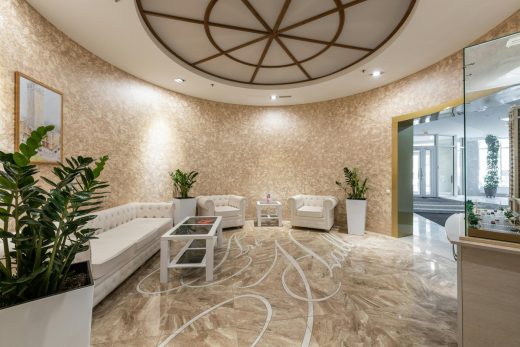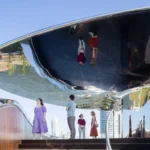Revolutionizing hotel restaurants service and operations tech, Checking in services, Accommodation branding
Revolutionizing Hotel Restaurants Tech for Service and Operations
15 May 2025
In recent years, the hospitality industry has undergone a profound transformation, with hotel restaurants standing at the crossroads of tradition and technology. As guests become more digitally connected and their expectations more sophisticated, the operational demands on hotel dining venues have intensified. Today, it’s no longer sufficient for hotel restaurants to simply deliver a great meal; they must also offer seamless service, personalized guest experiences, and real-time responsiveness. This evolution has brought a critical question to the forefront: Why Modern Hotel Restaurants Need Integrated Software?
Revolutionizing Hotel Restaurants: The Tech Behind Better Service and Operations
Digital innovation now plays a decisive role in how hotel dining spaces operate—from back-of-house inventory systems to front-of-house guest interactions. An isolated point-of-sale (POS) system or standalone reservation tool is no longer enough to ensure efficiency or guest satisfaction. Instead, integrated systems that unify reservation management, kitchen operations, and guest communication are setting new standards for excellence in hospitality. In this context, integrated restaurant software for hotels is no longer a luxury, but a strategic imperative.
The Changing Landscape of Hotel Dining
Hotel dining has traditionally played a dual role: serving as a key revenue generator and as an ambassador of the hotel’s overall brand. However, shifting consumer expectations and rapid technological developments have turned hotel restaurants into complex operational ecosystems. Guests now expect more than just prompt service and quality dishes—they look for a holistic, intuitive dining experience that reflects the modern convenience they enjoy in other areas of life. This includes mobile reservations, personalized menu recommendations, and digital loyalty programs that remember preferences across multiple visits or properties. To meet these expectations, hoteliers must rethink their operational frameworks and embrace digitally integrated solutions.
Moreover, the pandemic accelerated the digital transformation of the hospitality industry, exposing inefficiencies in traditional systems. Contactless dining, QR code menus, real-time table availability, and integrated communication between kitchen and waitstaff became necessities rather than innovations. These developments laid the foundation for long-term change. Hotels that adapted swiftly found themselves better positioned to enhance guest satisfaction and optimize internal processes. Those who clung to outdated legacy systems struggled to meet even basic service demands, often falling short of the personalized experiences that modern guests crave.
“Hotel restaurants can no longer rely on isolated systems—success depends on unified digital workflows that serve both the kitchen and the customer.”
Key Benefits of Tech Integration in Hotel Restaurants
The integration of restaurant-specific software within the broader hotel infrastructure is one of the most impactful upgrades a hospitality business can undertake. Rather than dealing with multiple, disconnected tools, hotel operators can leverage centralized platforms that bring together booking systems, POS, inventory management, and guest data in real-time. This seamless flow of information not only reduces administrative burden but also enhances accuracy, coordination, and responsiveness. Staff no longer need to manually reconcile data between systems or duplicate efforts across departments; instead, they can focus on what matters most—delivering exceptional service.
Integrated software also enables predictive insights and automated functions that improve strategic decision-making. For instance, data from past dining reservations can help anticipate busy periods, optimize staffing, and adjust menu planning accordingly. By aligning front-of-house and back-of-house operations, restaurants can reduce food waste, improve inventory turnover, and avoid service bottlenecks. This synergy leads to improved operational efficiency, higher guest satisfaction, and ultimately, increased profitability. In fact, hotels that adopt integrated digital solutions often report measurable gains in both revenue per available seat hour (RevPASH) and customer retention rates.
Additional advantages include:
- Real-time synchronization between reservations and table availability
- Integration with guest profiles from the hotel’s CRM or PMS
- Automated updates on special dietary preferences or VIP alerts
- Dynamic menu management with inventory-based recommendations
- Centralized dashboards for holistic performance tracking
Real-World Applications: From Reservations to Room Service
One of the most compelling arguments for adopting integrated restaurant software in hotel environments lies in the practical advantages it offers across a wide range of everyday operations. From the moment a guest books a table at the hotel restaurant—whether online, through the front desk, or via a mobile app—the system can automatically coordinate table availability, dietary preferences, and staff allocations. In the past, this process required multiple steps and manual input, often resulting in miscommunication and missed opportunities. With integrated systems, everything flows through a single, synchronized platform, minimizing human error and enhancing the guest experience from the outset.
Beyond standard dining reservations, hotel restaurants often manage more complex offerings, such as in-room dining, poolside service, and large-scale event catering. Integrated systems shine in these scenarios, connecting guest profiles with dietary notes, room numbers, loyalty points, and even historical data from past stays. This creates opportunities for upselling and personalization. For example, a returning guest who frequently orders vegetarian dishes can be automatically offered plant-based room service specials. Or during check-in, the front desk can proactively recommend an available table during peak dining times, thanks to real-time data sync between departments.
This streamlined integration unlocks value across the entire guest journey. Whether managing a late-night room service order, coordinating banquet logistics, or tracking allergen data during a corporate event, hotel staff can access the same up-to-date information through a unified dashboard. This not only ensures consistency but also empowers employees to exceed expectations. Operational excellence becomes scalable, not reliant on individual expertise or makeshift workarounds. In high-performing hotels, integrated systems become the invisible backbone that makes personalized, responsive, and frictionless service possible.
Challenges and Misconceptions About Hotel Tech Adoption
Despite the clear advantages, many hotel operators remain hesitant to fully embrace integrated digital solutions—often due to persistent misconceptions or perceived barriers to implementation. One common belief is that such systems are expensive and only suitable for large-scale hotel chains. In reality, modern platforms have evolved to be modular and scalable, catering to a wide range of hotel sizes and budgets. Even boutique properties can benefit from tailored solutions that address their specific operational needs without overextending resources.
Another challenge lies in change management. Hotel staff may resist transitioning away from familiar legacy systems, especially if they associate new technology with steep learning curves or disruptions to service. However, most integrated restaurant software platforms today prioritize user-friendly design and intuitive interfaces, making the onboarding process relatively straightforward. Training modules, live support, and seamless integration with existing PMS or CRM systems reduce friction during the transition phase. Furthermore, once implemented, these systems often reduce the overall workload by automating routine tasks and eliminating data redundancies.
It’s also important to address the myth that digital systems depersonalize the guest experience. On the contrary, the opposite is true. Integrated software enables personalization at scale by tracking guest preferences, order history, and feedback across multiple touchpoints. Rather than replacing human interaction, it enhances it—empowering staff with the tools and information they need to provide thoughtful, anticipatory service. The fear of losing a “personal touch” is misplaced when technology is used to reinforce hospitality values rather than undermine them.
Decision-Making Insights: What to Look For in Hotel Restaurant Software
Choosing the right integrated software solution can feel overwhelming, especially in a market crowded with options that vary in scale, complexity, and feature sets. However, by focusing on specific, business-critical factors, hotel operators can navigate this decision-making process more confidently. The ideal system should not only align with current operational needs but also support future growth. Scalability is key: what works for a small hotel restaurant today must be capable of adapting as guest volumes, menu complexity, or service offerings evolve.
Compatibility with existing hotel infrastructure is another essential consideration. Seamless integration with the hotel’s property management system (PMS), point-of-sale (POS), and customer relationship management (CRM) tools ensures that data flows freely across departments. This enhances not only staff efficiency but also the overall guest experience. Ease of use should also be prioritized—software that requires excessive staff training or constant troubleshooting may negate the benefits it’s meant to provide. The goal is a system that empowers staff, not burdens them.
| Evaluation Criteria | Why It Matters |
| Scalability | Supports expansion, new services, or seasonal demand shifts |
| System Compatibility | Ensures data sync with PMS, POS, and other hotel systems |
| User Experience (UX) | Minimizes training time and onboarding friction |
| Support & Maintenance | Provides long-term reliability and vendor accountability |
| Analytics & Reporting | Enables data-driven decisions through customizable insights |
An ideal software solution should also offer robust analytics capabilities. Operators must be able to extract insights from booking patterns, dining preferences, and service feedback to inform strategic improvements. Systems that provide customizable reporting features allow for more agile and informed management—helping identify not only what works but also where to optimize. In a competitive market where margins are tight and expectations are high, these insights are invaluable.
What the Future Holds for Digitally Enhanced Hotel Dining
As technology continues to evolve, the future of hotel dining will be shaped not just by software integration, but by the intelligent use of data, automation, and AI-driven personalization. Hotels will increasingly rely on systems that can predict guest behavior, adjust menu offerings in real-time based on inventory or seasonality, and even recommend optimal staffing schedules. Voice-based ordering, AI-driven menu translations for international guests, and sustainability tracking through food waste analytics are no longer distant concepts—they are already on the horizon.
What’s more, guest expectations will only continue to rise. Travelers accustomed to seamless experiences with ride-sharing apps and online food delivery services will demand the same fluidity from hotel restaurants. Integration will go beyond operations and move into experience design—creating journeys where dining, accommodation, and leisure blend into a single narrative. In this new era, hospitality businesses that embrace integrated digital ecosystems will not only survive but thrive.
Ultimately, the conversation about why modern hotel restaurants need integrated software is not just about technology—it’s about transformation. It’s about reimagining what hotel dining can be when powered by tools that simplify complexity, foster collaboration, and empower teams to deliver excellence.
Comments on this guide to Revolutionizing hotel restaurants service and operations tech article are welcome.
Luxury Hotel Architectural Design
Luxury Hotel Architectural Designs
NoMad London, 4 Bow Street, Covent Garden, central London, England, UK
Design: Roman and Williams
NoMad London Hotel, Covent Garden
Metric Hotel, Westlake community, Los Angeles, Southern California, USA
Design: Aaron Neubert Architects
Metric Hotel
Property
Contemporary Property Articles – architectural selection below:
Comments / photos for the Revolutionizing hotel restaurants service and operations tech – Interior Design Guide page welcome








